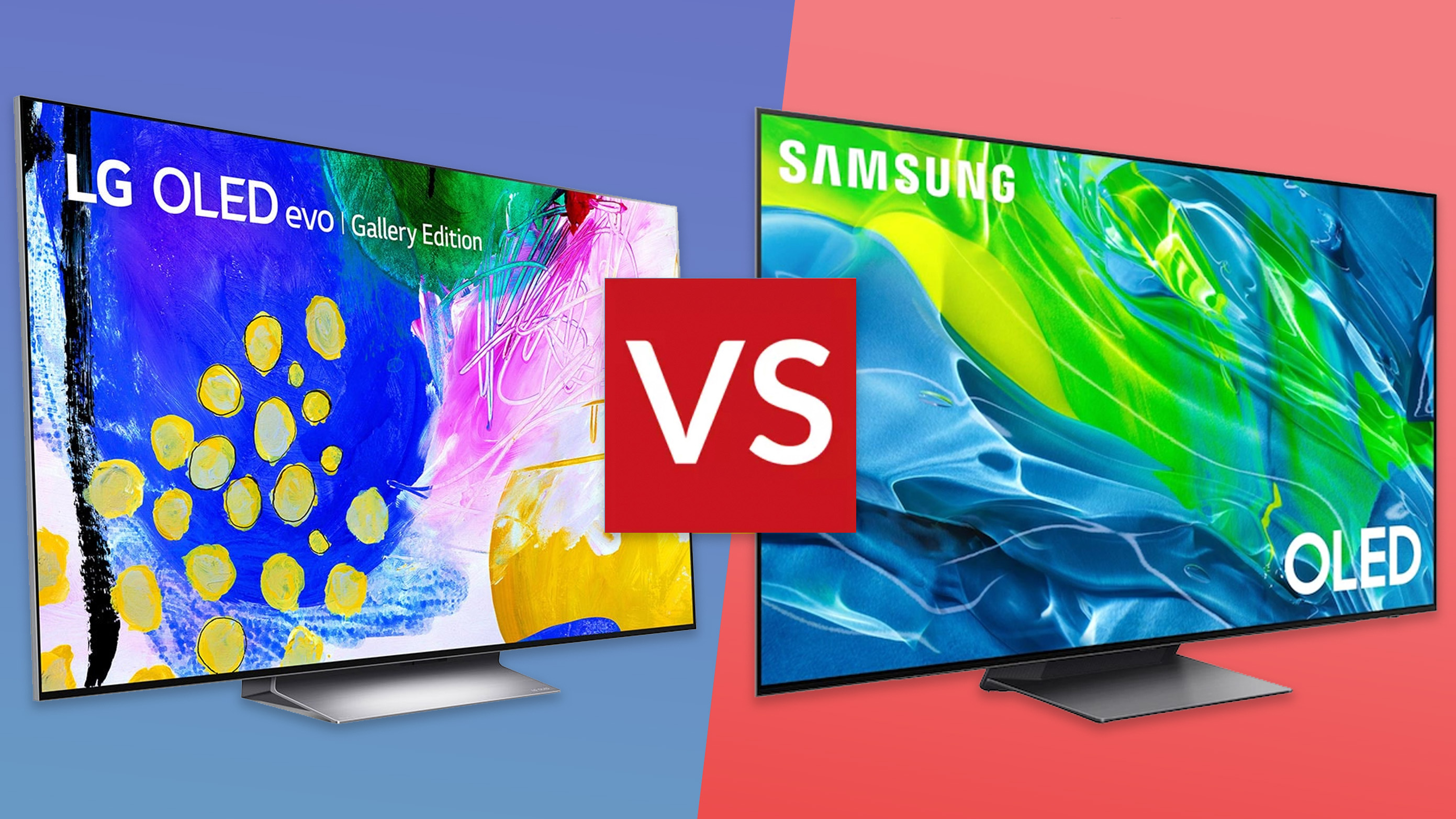

This year has been an exciting time for OLED fans, as LG and Samsung battle it out with two competing 4K HDR OLED TVs that both offer increased brightness and improved colours. Easily contenders for the best OLED TVs you can buy.
The LG G2 uses the new 'Evo' version of the brand’s long-established WRGB OLED panel, adding a heat sink to dissipate energy generated by an eye-blistering peak brightness of 1000 nits. Otherwise it’s business as usual, with a gorgeous 'Gallery Edition' design and a host of cutting-edge features.
Samsung returns to OLED after an absence of nearly a decade, with its superb S95B boasting an entirely new panel design based around Quantum Dots. Samsung claims its QD-OLED tech can deliver brighter highlights and purer colours, plus the S95B will include all the useful bells and whistles.
But which is better: LG G2 or Samsung S95B? We put both smart TVs through their paces and find out.
LG G2 vs Samsung S95B: PRICE & FEATURES
The LG G2 comes in 55-, 65-, 77- and 83-inch screen sizes, with pricing that reflects its high-end status. As a result, you can buy the OLED55G2 for £1,499, the OLED65G2 for £2,099/$2,199, the OLED77G2 for £3,799/$3,399, and the OLED83G2 for £5,499/$4,799.
The Samsung S95B is only available in available in two screen sizes, 55- and 65-inch, and despite using a cutting-edge panel design, it has recently enjoyed a significant price drop. As a result, the QE55S95B costs £1,249/$1,499, while the QE65S95B retails for £1,699/$1,899. It's a lot less than the LG, which may come as a surprise.
LG G2 vs Samsung S95B: DESIGN & CONNECTIONS
The LG G2 uses the latest Gallery Edition design, with a narrow bezel and non-chamfered chassis that’s only 22mm deep from top to bottom. The look is clean and simple, with an attractive metal trim around the outer edge, and a slight black border around the screen. This TV is primarily designed for wall-mounting, and includes a bracket, but there’s also an optional stand.
Get all the latest news, reviews, deals and buying guides on gorgeous tech, home and active products from the T3 experts
The G2 includes four HDMI 2.1 inputs, one with eARC, while all of them handle the latest gaming features such as 4K/120Hz, VRR, FreeSync, G-Sync, and ALLM. Additional connections include USB ports, terrestrial and satellite tuners, an optical output, a line output, a headphone socket, and an Ethernet port, along with Bluetooth, Apple’s AirPlay 2 and dual-band Wi-Fi.
The Samsung S95B sports a design that’s equally eye-catching, with a panel that’s mere millimetres thick, and some very minimalist stying with virtually no bezel. The ultra-slim chassis feels a little on the fragile side, but once attached to the stand the TV is more robust. However, it’s best to be careful during installation, especially when attaching to a bracket for wall mounting.
The S95B also has four HDMI 2.1 inputs, with eARC on one, and all of them capable of supporting the latest gaming features such as 4K/120Hz, VRR, FreeSync, and ALLM. Other connections include USB ports, terrestrial and satellite tuners, an optical digital output, an AV/headphone output, and an Ethernet port, along with Bluetooth, AirPlay 2, and dual-band Wi-Fi.
LG G2 vs Samsung S95B: PICTURE QUALITY
The LG G2 boasts a comprehensive set of features, with support for HDR10, HLG broadcast standard, and Dolby Vision, but not the HDR10+ format. The G2 includes the α9 Gen5 AI-enhanced processor, which also uses deep-learning algorithms to analyse and optimise content, plus the Evo panel is super-bright with high dynamic range (HDR) content. The result is an awesome performance, with effective upscaling, and motion enhancements, plus there’s Filmmaker Mode for improved image accuracy. This TV is also a great choice for gamers, with the Game Optimiser collating all the gaming options in a single useful interface, and delivering a similarly impressive 9ms input lag.
The Samsung S95B enjoys all the benefits you would normally associate with OLED, but the new panel builds on them to take the performance to another level. This results in colours that are bolder and truer, while the overall luminance and specular highlights of over 1000 nits are significantly brighter. The S95B supports HDR10, HLG, and HDR10+, but not Dolby Vision. The 4K Neural Quantum Processor ensures picture quality is always optimal, the motion handling is excellent, and the Filmmaker Mode retains creative intent. A Game Bar curates all the gaming features into a single convenient place, and the input lag is also a super-responsive 9ms.
LG G2 vs Samsung S95B: SOUND QUALITY
The LG G2 manages to sound great despite its narrow panel from top to bottom. The α9 Gen5 processor uses its increased processing power to apply multi-layer deep learning to an audio signal, adding virtual rear and overhead channels to create an immersive audio experience with Dolby Atmos. This processing not only produces a greater sense of envelopment, but also pulls dialogue out of the mix to make it more intelligible, which is often very useful. Check out the best soundbars for LG TVs to upgrade its output.
The Samsung S95B also sounds surprisingly good considering its ultra-slim design, but only uses the basic version of Samsung’s Object Tracking Sound technology. Overall the soundstage is well-balanced, with clear dialogue and a nice sense of spatial awareness giving the audio more dimensionality. Samsung now includes onboard Dolby Atmos decoding, and while the S95B will never sound genuinely immersive, it does a pretty good job with the speakers at its disposal. Check out the best soundbars for Samsung TVs to upgrade its output.
LG G2 vs Samsung S95B: SMART TV
The LG G2 runs the latest version of LG’s smart platform – webOS 22. This has been tweaked to make interaction more intuitive, allowing for greater customisation, and providing better recommendations. In terms of choice, all the major video streamers are present and correct, including Freeview Play for all the UK catch-up services.
The Magic Remote remains the best controller on the market, with an onscreen pointer that makes navigating the TV intuitive and fun. There are direct access buttons for Netflix, Prime Video, Disney+ and Rakuten TV, along with activation buttons for the built-in Alexa and Google assistants. There’s also a microphone for voice interaction, and an NFC tag.
The Samsung S95B uses the latest version of the brand’s Tizen-powered smart system, which is also comprehensive in its choice of video streaming apps. The platform can be a little sluggish at times, and not always intuitive to navigate, but the layout is designed to ensure you can always find the content you’re looking for, with plenty of recommendations.
Samsung provides two remote controls with the S95B: a standard black plastic zapper and a stripped down metal wand that uses solar-power for recharging, thus making replacing batteries a thing of the past. The latter is elegant and ergonomic in its design, with all the important buttons and some direct access keys for Netflix, Prime Video, Disney+.
LG G2 vs Samsung S95B: VERDICT
The LG G2 scales the zenith of the brand’s OLED TV range, with cutting-edge image processing, incredibly bright HDR pictures, and exceptional levels of accuracy. Once you add in great sound, extensive gaming features, and a smart system with a comprehensive choice of streaming services, you’ve got a cracking TV that looks particularly classy when wall-mounted.
The Samsung S95B represents a remarkable technological achievement, with awesome picture quality, a comprehensive smart system, and extensive gaming features. The sound system is limited by the ultra-slim design and there’s no support for Dolby Vision, but otherwise this cutting-edge QD-OLED TV is hard to fault and even harder to resist at its current prices.

Steve Withers is a professional calibrator and freelance journalist who regularly contributes to T3, reviewing audio and video products, and writing articles. Steve has been writing about audio and video products for over ten years and, along with T3, he also contributes to TechRadar, Trusted Reviews, Expert Reviews, AVForums, Pocket-lint, Home Cinema Choice, and Wired. Steve is Level 2 certified with THX, the Imaging Science Foundation (ISF) and the Home Acoustics Alliance (HAA). As such, he remains abreast of all AV technology developments and the latest industry standards as we transition into a new era in home video and audio.